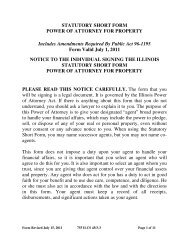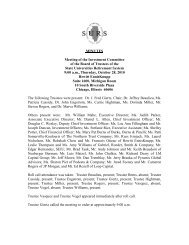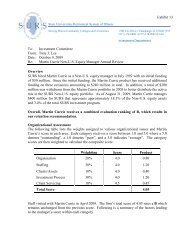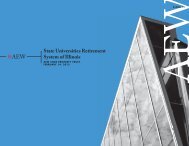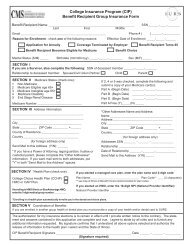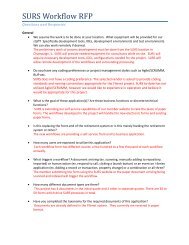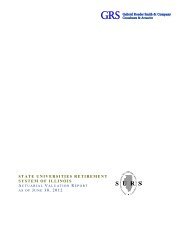Create successful ePaper yourself
Turn your PDF publications into a flip-book with our unique Google optimized e-Paper software.
Exhibit 1<br />
<strong>SURS</strong> <strong>Audit</strong> Committee Structure and Review<br />
John Engstrom, Chair<br />
November 10, 2009<br />
1. I am now comfortable with t<strong>he</strong> role of t<strong>he</strong> audit committee as a part of<br />
<strong>SURS</strong> Board governance. This has come about as a result of many<br />
conversations and information provided by Steve Hayward, <strong>SURS</strong> Internal<br />
<strong>Audit</strong>or, conversations with a number of ot<strong>he</strong>r people, and research of t<strong>he</strong><br />
literature, especially provided by t<strong>he</strong> Institute of Internal <strong>Audit</strong>ors (IIA) and<br />
t<strong>he</strong> American Institute of Certified Public Accountants (AICPA). As a CPA, I<br />
have a professional responsibility to ensure that we meet IIA and AICPA<br />
standards. Failure to provide oversight could have significant legal and<br />
financial consequences to Board Members, in t<strong>he</strong> event of a fiscal failure.<br />
2. It is recommended that <strong>Audit</strong> Committees operate under a charter.<br />
Effectively, our charter is Section 15.2 “Duties of t<strong>he</strong> <strong>Audit</strong> Committee” of<br />
t<strong>he</strong> <strong>SURS</strong> By‐laws.<br />
3. T<strong>he</strong> AICPA has t<strong>he</strong> AICPA <strong>Audit</strong> Committee Toolkit: Government<br />
Organizations with information regarding how to create an audit<br />
committee and to <strong>he</strong>lp its operations. T<strong>he</strong> Toolkit has c<strong>he</strong>cklists,<br />
questionnaires, and ot<strong>he</strong>r useful information. This can be found on t<strong>he</strong>ir<br />
website, www.aicpa.org.<br />
4. Most of t<strong>he</strong> literature makes t<strong>he</strong> assumption that t<strong>he</strong> <strong>Audit</strong> Committee<br />
manages t<strong>he</strong> process of obtaining t<strong>he</strong> external auditor and is t<strong>he</strong> main point<br />
of contact with t<strong>he</strong> external auditor. In Illinois, certain constraints are in<br />
place that modify what we can and should do. First, t<strong>he</strong> external auditors of<br />
all state agencies are employed by t<strong>he</strong> State <strong>Audit</strong>or‐General and report to<br />
that office, t<strong>he</strong> Office of t<strong>he</strong> <strong>Audit</strong>or General (OAG). With Steve Hayward’s<br />
<strong>he</strong>lp, I now have contact with Mr. Tom Kizziah, our representative with<br />
OAG. A second constraint is t<strong>he</strong> open meetings act. Most of t<strong>he</strong> audit<br />
literature suggests frequent executive sessions with t<strong>he</strong> external auditor<br />
w<strong>he</strong>re frank and open discussions can result. T<strong>he</strong> literature also suggests<br />
that only audit committee members be in on t<strong>he</strong>se discussions; a third<br />
constraint is t<strong>he</strong> tradition of <strong>SURS</strong> that all Board members can attend, make
Exhibit 1<br />
motions, and vote in all committee meetings (except t<strong>he</strong> executive<br />
committee). None of t<strong>he</strong>se constraints should keep us from exercising<br />
oversight, in my judgment.<br />
5. Our current auditor is McGladrey and Pullen, in t<strong>he</strong> second year of a six<br />
year contract. One responsibility of t<strong>he</strong> audit committee is to respond to an<br />
internal control set of questions (called a Statement on <strong>Audit</strong>ing Standards<br />
(SAS) 99 questionnaire). I responded to those questions by an audit<br />
manager on Wednesday, October 14.<br />
6. I will recommend that t<strong>he</strong> <strong>Audit</strong> Committee meet with t<strong>he</strong> external auditor<br />
and t<strong>he</strong> OAG representative to <strong>he</strong>ar t<strong>he</strong> results of t<strong>he</strong> 2008‐9 financial and<br />
compliance audits. This will happen w<strong>he</strong>n t<strong>he</strong> OAG finalizes t<strong>he</strong> audit<br />
reports and releases t<strong>he</strong>m to t<strong>he</strong> public. Procedurally, our (Acting?)<br />
Executive Director will make t<strong>he</strong> request to t<strong>he</strong> State <strong>Audit</strong>or‐General. A<br />
part of that meeting should be in executive session.<br />
7. I have read t<strong>he</strong> “Fiscal Control and Internal <strong>Audit</strong>ing Act” provided by Steve<br />
Hayward. This act requires that t<strong>he</strong> internal auditor report to t<strong>he</strong> chief<br />
executive officer of each agency and provides for t<strong>he</strong> adoption of two‐year<br />
plans, etc. We meet those requirements. This Act also requires state<br />
auditors to comply with Institute of Internal <strong>Audit</strong>ors’ international<br />
standards, ethics and ot<strong>he</strong>r standards adopted by t<strong>he</strong> State Internal <strong>Audit</strong><br />
Advisory Board. Recent law changes under SB 51 (PA 096‐0795) formally<br />
bring t<strong>he</strong> state pension boards under t<strong>he</strong> act.<br />
8. Steve Hayward has provided me with (a) <strong>SURS</strong> Fraud Policies and<br />
Procedures, (b) <strong>SURS</strong> Internal <strong>Audit</strong> Charter and Policies and Procedures<br />
Manual, (c) a letter from Judy Parker to Bill Holland, <strong>Audit</strong>or General,<br />
reporting that an evaluation of t<strong>he</strong> internal fiscal and administrative<br />
controls was performed during t<strong>he</strong> reporting period ending April 1, 2009,<br />
and (d) report of external assessment of t<strong>he</strong> <strong>SURS</strong> Internal <strong>Audit</strong><br />
Department to t<strong>he</strong> IIA standards and t<strong>he</strong> Fiscal Control and Internal<br />
<strong>Audit</strong>ing Act of t<strong>he</strong> State of Illinois. T<strong>he</strong> date of t<strong>he</strong> report was September<br />
6, 2006; t<strong>he</strong> external audit was performed by t<strong>he</strong> TRS Internal <strong>Audit</strong><br />
Manager.
Exhibit 1<br />
9. I believe t<strong>he</strong> internal audit function of t<strong>he</strong> <strong>SURS</strong> staff is operating effectively<br />
and in accordance with state regulations and professional standards. I<br />
believe procedures are in place for t<strong>he</strong> <strong>Audit</strong> Committee to be notified in<br />
t<strong>he</strong> event significant internal control problems are detected, eit<strong>he</strong>r by t<strong>he</strong><br />
external auditor, t<strong>he</strong> OAG representative, or t<strong>he</strong> <strong>SURS</strong> internal auditor.<br />
10. In t<strong>he</strong> future, I suggest that we have at least one formal meeting each year<br />
with t<strong>he</strong> external auditor and t<strong>he</strong> OAG representative, that t<strong>he</strong> audit<br />
committee and ot<strong>he</strong>r Board members read carefully t<strong>he</strong> materials<br />
presented by Steve Hayward in our meetings, and that we all adopt a<br />
questioning attitude towards <strong>SURS</strong> actions in terms of t<strong>he</strong>ir internal control<br />
and potential fraud implications. In t<strong>he</strong> words of an Institute of Internal<br />
<strong>Audit</strong>ors publication (T<strong>he</strong> <strong>Audit</strong> Committee: Purpose, Process,<br />
Professionalism) “noses in, fingers out.”




